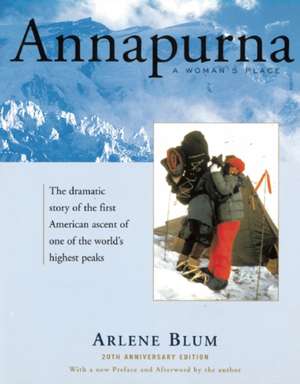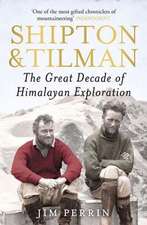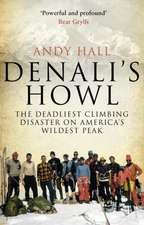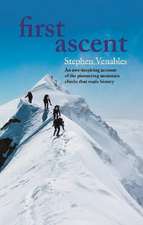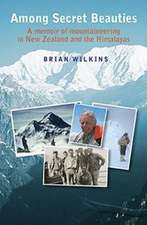Annapurna: A Woman's Place
Autor Arlene Blumen Limba Engleză Paperback – 14 sep 2015
In August 1978, thirteen women left San Francisco for the Nepal Himalaya to make history as the first Americans—and the first women—to scale the treacherous slopes of Annapurna I, the world’s tenth highest peak. Expedition leader Arlene Blum here tells their dramatic story: the logistical problems, storms, and hazardous ice climbing; the conflicts and reconciliations within the team; the terror of avalanches that threatened to sweep away camps and climbers.
On October 15, two women and two Sherpas at last stood on the summit—but the celebration was cut short, for two days later, the two women of the second summit team fell to their deaths. Never before has such an account of mountaineering triumph and tragedy been told from a woman’s point of view. By proving that women had the skill, strength, and courage necessary to make this difficult and dangerous climb, the 1978 Women's Himalayan Expedition’s accomplishment had a positive impact around the world, changing perceptions about women’s abilities in sports and other arenas. And Annapurna: A Woman’s Place has become an acknowledged classic in the annals of women’s achievements—a story of challenge and commitment told with passion, humor, and unflinching honesty.
On October 15, two women and two Sherpas at last stood on the summit—but the celebration was cut short, for two days later, the two women of the second summit team fell to their deaths. Never before has such an account of mountaineering triumph and tragedy been told from a woman’s point of view. By proving that women had the skill, strength, and courage necessary to make this difficult and dangerous climb, the 1978 Women's Himalayan Expedition’s accomplishment had a positive impact around the world, changing perceptions about women’s abilities in sports and other arenas. And Annapurna: A Woman’s Place has become an acknowledged classic in the annals of women’s achievements—a story of challenge and commitment told with passion, humor, and unflinching honesty.
Preț: 114.23 lei
Nou
Puncte Express: 171
Preț estimativ în valută:
21.86€ • 22.88$ • 18.19£
21.86€ • 22.88$ • 18.19£
Carte disponibilă
Livrare economică 10-24 martie
Preluare comenzi: 021 569.72.76
Specificații
ISBN-13: 9781619026032
ISBN-10: 1619026031
Pagini: 272
Ilustrații: 118 B&W photos, B&W illustrations, maps
Dimensiuni: 183 x 231 x 20 mm
Greutate: 0.43 kg
Editura: Counterpoint Press
Colecția Counterpoint
ISBN-10: 1619026031
Pagini: 272
Ilustrații: 118 B&W photos, B&W illustrations, maps
Dimensiuni: 183 x 231 x 20 mm
Greutate: 0.43 kg
Editura: Counterpoint Press
Colecția Counterpoint
Recenzii
This is a book about working together under extraordinary conditions where the temperature in your tent can drop to ten degrees below zero and a tiny hole in a glove can mean the possible loss of a finger. It is about making decisions while an avalanche rushes by you with a wind that knocks you over. It is about risking death knowing that you have a daughter, a partner at home . . . the compelling story of thirteen very different women . . . each determined to get women to the top of a mountain. —Erica Bauermeister, reviewed in 500 Great Books by Women
Notă biografică
Arlene Blum is a biochemist with a doctorate in physical chemistry. In her twenty years of climbing, she has taken part in more than fifteen expeditions, including the first all-woman climb of Mount McKinley and the 1976 American Bicentennial Expedition to Mount Everest. Ms. Blum also led the 1983 Great Himalayan Traverse, a 2,000-mile trek from Bhutan to Ladakh. She lives in Berkeley, California.
Extras
Introduction:
In 1994 I was studying for a graduate degree in literature at Colorado State University. My driving passion was climbing, and I was far more interested in glaciers and walls than literary theory. Although mountaineering literature was not in the curriculum, my advisors approved it for my thesis if the project included a comprehensive bibliography of works, and synopses of them, that I considered pivotal to the genre. For a year I pillaged the mountaineering sections of used bookstores in Boulder, fanatically devouring stacks of climbing books. My bibliography started with Dante’s Inferno and ended at Climbing Magazine, and of course it included Arlene Blum’s Annapurna.
A steady diet of expedition accounts left me with an overriding impression that shaped my master’s thesis and every climbing story I’ve written myself. Inevitably, the climber writing an expedition account also created the enduring history of his team members’ actions and motivations—and in a remarkable number of expedition accounts, everyone else on the team was difficult, less competent or at least slightly less heroic. My thesis was called “The Reality of Experience in Mountaineering Literature,” and the premise was that one should not presume to tell someone else’s story or make assumptions about their motivations, and that there are many different truths. Even with a team of two, each climber will have a unique experience on a climb, both internal and external. As a result, it can be a delicate and thorny task for a climber to tell her own story when the story also involves others, especially when the experience is complex, emotionally charged and worth the telling.
Arlene’s writing is so intelligent and fresh that the story of the climb itself—building the team, fundraising, travel, managing porters, choosing the line, setting camps, climbing the mountain—sweeps you along as though you were part of the adventure. Although she sets the stage to include the moments of bias encountered by a women’s team going for a major 8000 meter peak in 1978, Arlene clearly views herself and her group as climbers above all. At times it’s easy to forget the dramatically different social landscape surrounding them.
But what sets Annapurna apart are Arlene’s internal challenges as expedition leader and chronicler, offered up honestly and without aggrandizement. She writes candidly about the difficulties of making decisions and handling leadership, complete with missteps and doubts. Both during and after the climb, she analyzes the inevitable conflicts, ponders her own reactions and considers others’ perspectives. Coming back to Annapurna twenty years after the first read, I can see how Arlene became a role model for me at that formative phase in my life as a budding author and climber.
Annapurna: A Woman’s Place, is an enduring book because it resonates on multiple levels. The team made an impressive climb, in conditions which were marginal at best and which never allowed clean decision making for anyone on the mountain. Arlene’s introspective and expansive account of their ascent offers not just a tale of adventure but also a reflection on leadership, responsibility, self awareness and personal strength.
In 1994 I was studying for a graduate degree in literature at Colorado State University. My driving passion was climbing, and I was far more interested in glaciers and walls than literary theory. Although mountaineering literature was not in the curriculum, my advisors approved it for my thesis if the project included a comprehensive bibliography of works, and synopses of them, that I considered pivotal to the genre. For a year I pillaged the mountaineering sections of used bookstores in Boulder, fanatically devouring stacks of climbing books. My bibliography started with Dante’s Inferno and ended at Climbing Magazine, and of course it included Arlene Blum’s Annapurna.
A steady diet of expedition accounts left me with an overriding impression that shaped my master’s thesis and every climbing story I’ve written myself. Inevitably, the climber writing an expedition account also created the enduring history of his team members’ actions and motivations—and in a remarkable number of expedition accounts, everyone else on the team was difficult, less competent or at least slightly less heroic. My thesis was called “The Reality of Experience in Mountaineering Literature,” and the premise was that one should not presume to tell someone else’s story or make assumptions about their motivations, and that there are many different truths. Even with a team of two, each climber will have a unique experience on a climb, both internal and external. As a result, it can be a delicate and thorny task for a climber to tell her own story when the story also involves others, especially when the experience is complex, emotionally charged and worth the telling.
Arlene’s writing is so intelligent and fresh that the story of the climb itself—building the team, fundraising, travel, managing porters, choosing the line, setting camps, climbing the mountain—sweeps you along as though you were part of the adventure. Although she sets the stage to include the moments of bias encountered by a women’s team going for a major 8000 meter peak in 1978, Arlene clearly views herself and her group as climbers above all. At times it’s easy to forget the dramatically different social landscape surrounding them.
But what sets Annapurna apart are Arlene’s internal challenges as expedition leader and chronicler, offered up honestly and without aggrandizement. She writes candidly about the difficulties of making decisions and handling leadership, complete with missteps and doubts. Both during and after the climb, she analyzes the inevitable conflicts, ponders her own reactions and considers others’ perspectives. Coming back to Annapurna twenty years after the first read, I can see how Arlene became a role model for me at that formative phase in my life as a budding author and climber.
Annapurna: A Woman’s Place, is an enduring book because it resonates on multiple levels. The team made an impressive climb, in conditions which were marginal at best and which never allowed clean decision making for anyone on the mountain. Arlene’s introspective and expansive account of their ascent offers not just a tale of adventure but also a reflection on leadership, responsibility, self awareness and personal strength.
